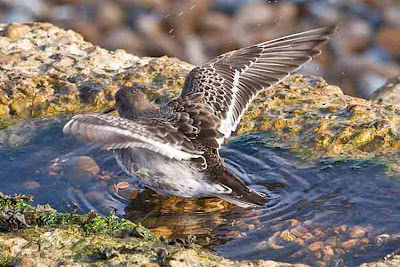My phone went while I was in the one way system of Dover on my way out of town. Parking safely (of course), I returned Steve Ray's call and found that he was only a few hundred yards away, on the Prince of Wales Pier and was watching a Grey (Red) Phalarope. A little bird with two names! It is red in the breeding season, hence the widespread name, but on migration we see them in their grey plumage, hence the parochial English name.
 When I arrived it had temporarily gone missing, but a few terns were performing well and As far as I could see we had a group of five Arctic Terns.
When I arrived it had temporarily gone missing, but a few terns were performing well and As far as I could see we had a group of five Arctic Terns. They all had white secondaries and no dark secondary bar. The bill looked quite small and dark and the carpal bar quite narrow and diffuse.
They all had white secondaries and no dark secondary bar. The bill looked quite small and dark and the carpal bar quite narrow and diffuse.

 I suspect that it had been just below us all the time. Unfortunately the shadow cast by the pier meant that it stayed out of the sunshine all the time.
I suspect that it had been just below us all the time. Unfortunately the shadow cast by the pier meant that it stayed out of the sunshine all the time. It busied itself picking at the surface, finding small items of food amongst the bit and pieces floating in the water.
It busied itself picking at the surface, finding small items of food amongst the bit and pieces floating in the water. The water was quite clear and it was possible to make out the rather strange lobed feet that are characteristic of Phalaropes.
The water was quite clear and it was possible to make out the rather strange lobed feet that are characteristic of Phalaropes.

 It seemed interested in this primary feather, which would have been rather too large for it to wear!
It seemed interested in this primary feather, which would have been rather too large for it to wear! This is what a Grey Phalarope looks like in Summer and why the name Red Phalarope is quite appropriate. I took this in 2005 on Spitsbergen.
This is what a Grey Phalarope looks like in Summer and why the name Red Phalarope is quite appropriate. I took this in 2005 on Spitsbergen.Just to add to the charms of the harbour Phil Smith informed us that a Purple Sandpiper had been seen on one of the concrete groynes opposite the flats. When we located it, it was bathing in a small puddle on top.
 Although I've seen Purple Sandpipers around the harbour before, they've always been quite distant, so it was good to be able to get a close look.
Although I've seen Purple Sandpipers around the harbour before, they've always been quite distant, so it was good to be able to get a close look.



 I've always though that the matching beak and legs make a strong fashion statement. More Pictures here.
I've always though that the matching beak and legs make a strong fashion statement. More Pictures here.

3 comments:
Nice photos of the Sandpiper Tony, they made a nice change.
The details of the phalarope were a bit confusing - when the Grey Phalarope becomes the Red Phalarope I presume that this still means that the Red-necked Phlarope is a seperate bird.
Derek, reach for the book shelf!
There are three phalarope species, Wilson's, N America only. Two species, the Red Phalarope (Phalaropus fulicarius, called Grey Phalarope in Europe) and Red-necked Phalarope (P. lobatus) breed around the Arctic Circle and winter on tropical oceans. Wilson's Phalarope (P. tricolor) breeds in western North America and migrates to South America.
Tony
nice write up about a super bird
Post a Comment